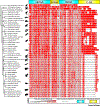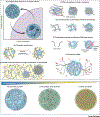Phase separation in genome organization across evolution
- PMID: 33771451
- PMCID: PMC8286288
- DOI: 10.1016/j.tcb.2021.03.001
Phase separation in genome organization across evolution
Abstract
Phase separation is emerging as a paradigm to explain the self-assembly and organization of membraneless bodies in the cell. Recent advances show that this principle also extends to nucleoprotein complexes, including DNA-based structures. We discuss here recent observations on the role of phase separation in genome organization across the evolutionary spectrum from bacteria to mammals. These findings suggest that molecular interactions amongst DNA-binding proteins evolved to form a variety of biomolecular condensates with distinct material properties that affect genome organization and function. We suggest that phase separation contributes to genome organization across evolution and that the resulting phase behavior of genomes may underlie regulatory mechanisms and disease.
Keywords: biomolecular condensates; evolution; genome organization; phase separation; transcription.
Published by Elsevier Ltd.
Conflict of interest statement
Declaration of interests The authors declare no competing interests.
Figures




Similar articles
-
Biological colloids: Unique properties of membraneless organelles in the cell.Adv Colloid Interface Sci. 2022 Dec;310:102777. doi: 10.1016/j.cis.2022.102777. Epub 2022 Sep 19. Adv Colloid Interface Sci. 2022. PMID: 36279601 Review.
-
Splicing regulation through biomolecular condensates and membraneless organelles.Nat Rev Mol Cell Biol. 2024 Sep;25(9):683-700. doi: 10.1038/s41580-024-00739-7. Epub 2024 May 21. Nat Rev Mol Cell Biol. 2024. PMID: 38773325 Free PMC article. Review.
-
Sequence variations of phase-separating proteins and resources for studying biomolecular condensates.Acta Biochim Biophys Sin (Shanghai). 2023 Jul 18;55(7):1119-1132. doi: 10.3724/abbs.2023131. Acta Biochim Biophys Sin (Shanghai). 2023. PMID: 37464880 Free PMC article. Review.
-
Roles of liquid-liquid phase separation in bacterial RNA metabolism.Curr Opin Microbiol. 2021 Jun;61:91-98. doi: 10.1016/j.mib.2021.03.005. Epub 2021 Apr 18. Curr Opin Microbiol. 2021. PMID: 33878678 Free PMC article. Review.
-
Biological Liquid-Liquid Phase Separation, Biomolecular Condensates, and Membraneless Organelles: Now You See Me, Now You Don't.Int J Mol Sci. 2023 Aug 24;24(17):13150. doi: 10.3390/ijms241713150. Int J Mol Sci. 2023. PMID: 37685957 Free PMC article.
Cited by
-
Identification, characterization and classification of prokaryotic nucleoid-associated proteins.Mol Microbiol. 2025 Mar;123(3):206-217. doi: 10.1111/mmi.15298. Epub 2024 Jul 22. Mol Microbiol. 2025. PMID: 39039769 Free PMC article. Review.
-
Chromosome compartmentalization: causes, changes, consequences, and conundrums.Trends Cell Biol. 2024 Sep;34(9):707-727. doi: 10.1016/j.tcb.2024.01.009. Epub 2024 Feb 22. Trends Cell Biol. 2024. PMID: 38395734 Review.
-
Bacterial Transcriptional Regulators: A Road Map for Functional, Structural, and Biophysical Characterization.Int J Mol Sci. 2022 Feb 16;23(4):2179. doi: 10.3390/ijms23042179. Int J Mol Sci. 2022. PMID: 35216300 Free PMC article. Review.
-
The Regulatory Roles of Intrinsically Disordered Linker in VRN1-DNA Phase Separation.Int J Mol Sci. 2022 Apr 21;23(9):4594. doi: 10.3390/ijms23094594. Int J Mol Sci. 2022. PMID: 35562982 Free PMC article.
-
Macromolecular Crowding, Phase Separation, and Homeostasis in the Orchestration of Bacterial Cellular Functions.Chem Rev. 2024 Feb 28;124(4):1899-1949. doi: 10.1021/acs.chemrev.3c00622. Epub 2024 Feb 8. Chem Rev. 2024. PMID: 38331392 Free PMC article. Review.
References
-
- Hyman AA et al. (2014) Liquid-liquid phase separation in biology. Annu. Rev. Cell. Dev. Bi 30, 39–58. - PubMed
-
- Brangwynne CP et al. (2015) Polymer physics of intracellular phase transitions. Nat. Phys 11 (11), 899–904.
-
- Brangwynne CP et al. (2009) Germline P granules are liquid droplets that localize by controlled dissolution/condensation. Science 324 (5935), 1729–1732. - PubMed
Publication types
MeSH terms
Grants and funding
LinkOut - more resources
Full Text Sources
Other Literature Sources

